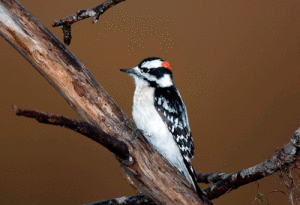
Downy Woodpeckers are one of the many woodpecker species found in Texas.
Photo by Mike Williams
Woody Woodpecker, the animated cartoon, sure was a character! Lively, loud, and kinda crazy! And he was modeled after a real and local woodpecker, the Pileated Woodpecker. While Pileated Woodpeckers may be loud, they aren’t as crazy or quite as animated as Woody was. They are, however, the largest of the woodpeckers in our area, coming in at a whopping 17 inches long with a wingspan of 29 inches. That’s a lot of wood-chucking bird!
We actually have quite a few woodpecker species here, although some are specialized to certain habitats or areas. They may seem like pests to some, as they like to tap on our houses, at times destroying wooden eves. However, they are quite important in nature to keep an important balance of insects, and maybe even more for their role in creating nesting holes that many other woodland birds use to nest in. In fact, they are named a keystone species for that role! Most birds can’t hollow out a tree, so that role goes to woodpeckers.
We have eight species of woodpeckers in the region if you count inland a ways. From giant to tiny! They are fascinating, and important.
Probably the most abundant is the Red-bellied Woodpecker who frequents most habitats except the beach. They love old neighborhoods with older trees, and will readily come to feeders, especially suet, and bird baths. They are often confused with the Red-headed Woodpecker, who is rarer and inhabits more wild and wooded areas. Red-headed often like stands of tall dead trees in more open areas in a woodland. They have completely red heads compared to the Red-bellied who just has red on the top of head and/or nape (neck).
The Downy Woodpecker is the smallest, and also frequents yards and feeders, as well as woods, ranches, and many other habitats. I would think it’s the second most numerous in our area. They have a southerly cousin, the Ladder-backed Woodpecker which barely gets into our area but can be found with persistence, and can be confused as their calls are similar. The Downy’s larger cousin is the rarer and much further inland forest dweller, the Hairy Woodpecker. Besides their size difference, there is a black spot on the Downy’s out tail fathers that is missing on the Hairy.
Another rare forest woodpecker is the Red-cockaded Woodpecker, an endangered species that only lives in very specific forest habitats in what’s more known as the southern part of East Texas. They require long-leaf pine savannas, and are very particular about which trees they nest in. There are only about 14,000 of them remaining, and a conservation program is trying to help them recover in their very limited range.
The last of our woodpeckers only comes and visits us in the winter months. The Northern Flicker is a loud visitor with a loud sharp “keew” call! They are quite distinct in their plumage and colors from the others who are all pretty much black and white with some small part of their heads red. They like wooded areas, especially edges of woods, and will frequent parks and golf courses, etc. They have two subspecies, the yellow-shafted and red-shafted, named from the color of their underwings. Flickers often feed on the ground foraging for ants, but still make nest holes in trees.
I’m writing this article as I watch a Red-bellied forage in the large oak tree outside my window, working up the trunk and out under branches, here at the Gulf Coast Bird Observatory. They sure are fascinating to watch, and I hope you get to enjoy frequent and fun encounters with them!
